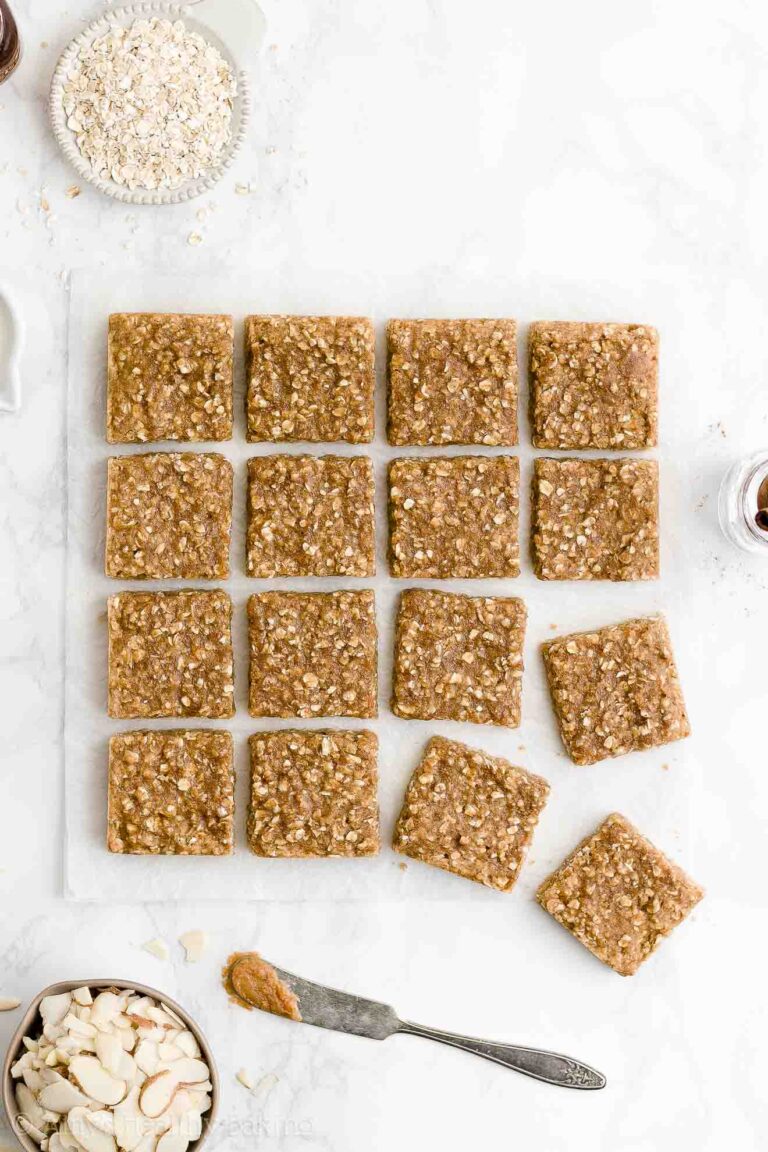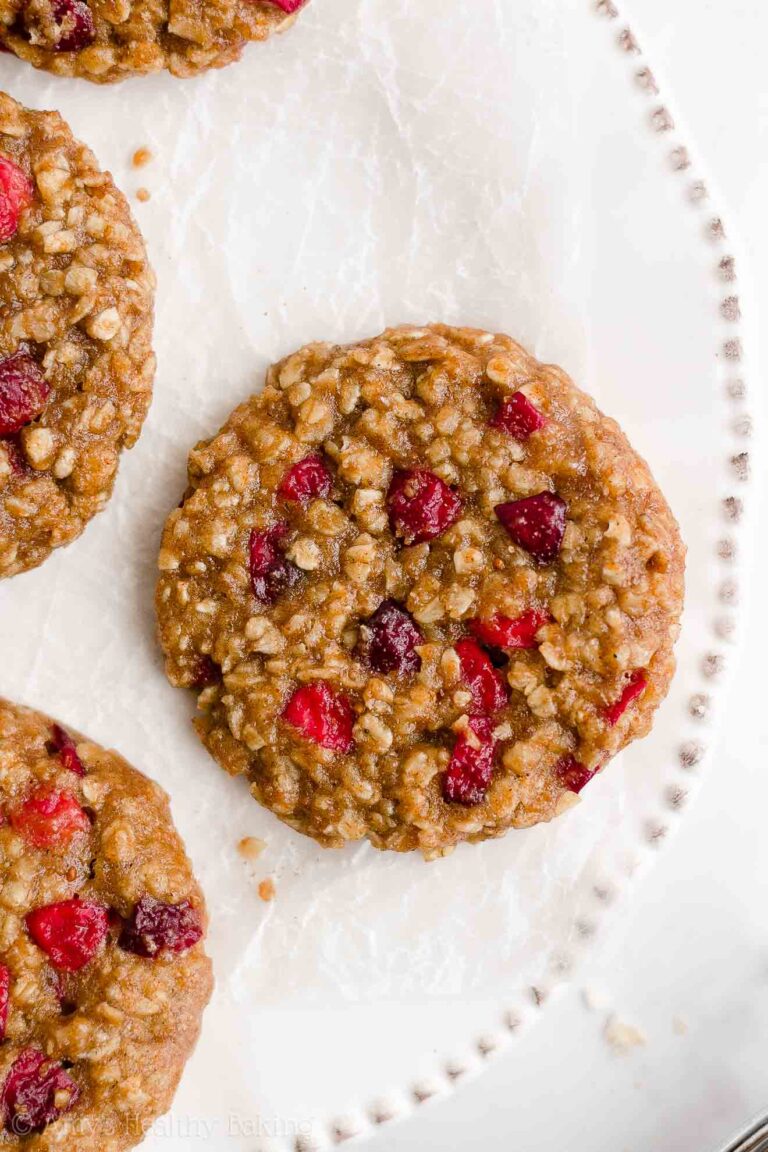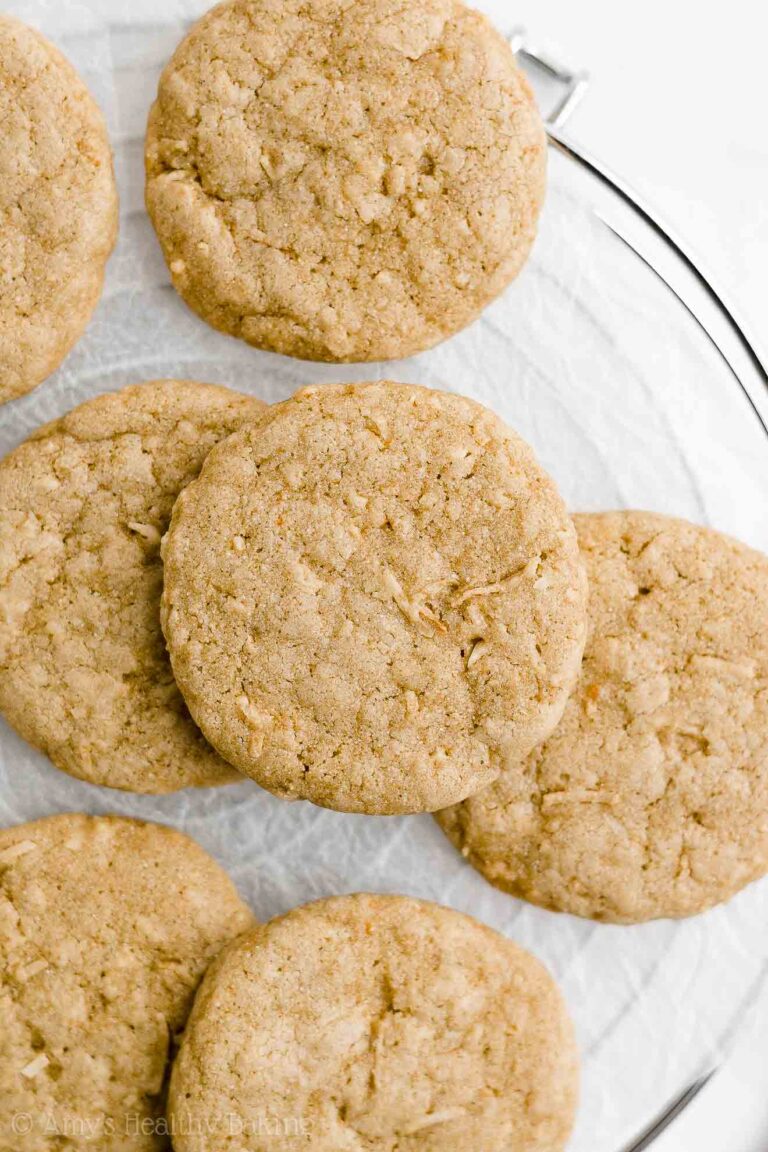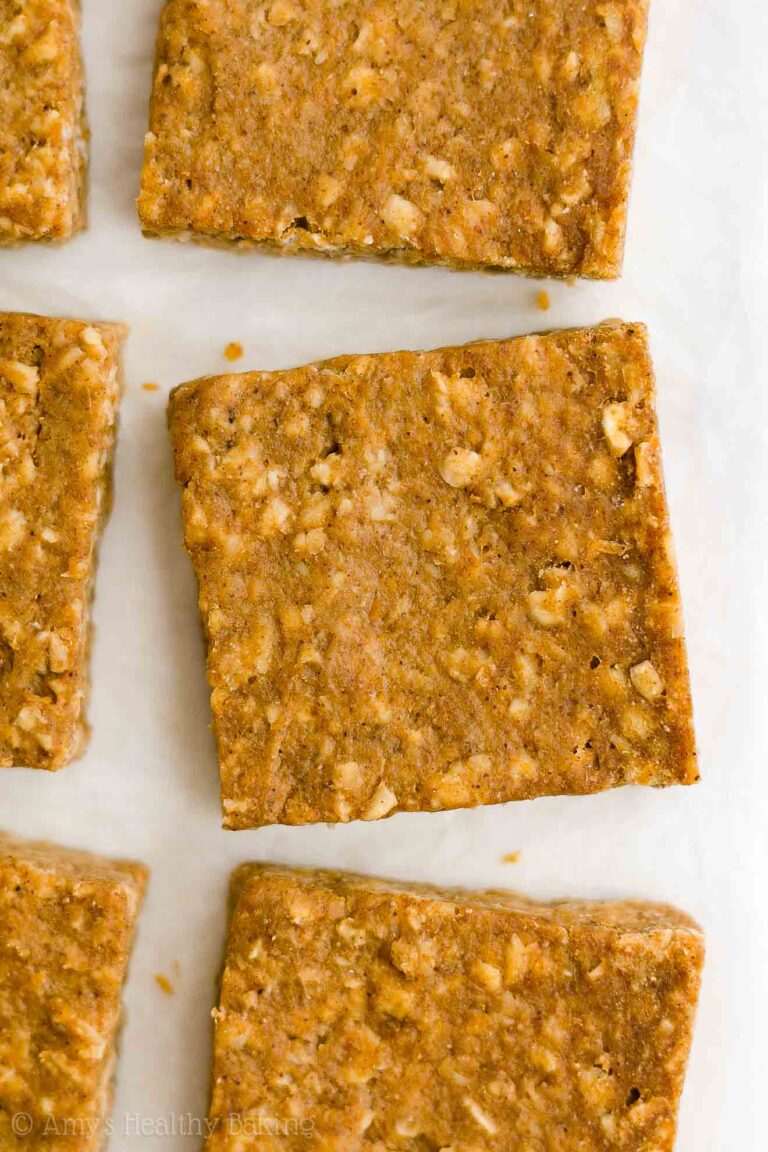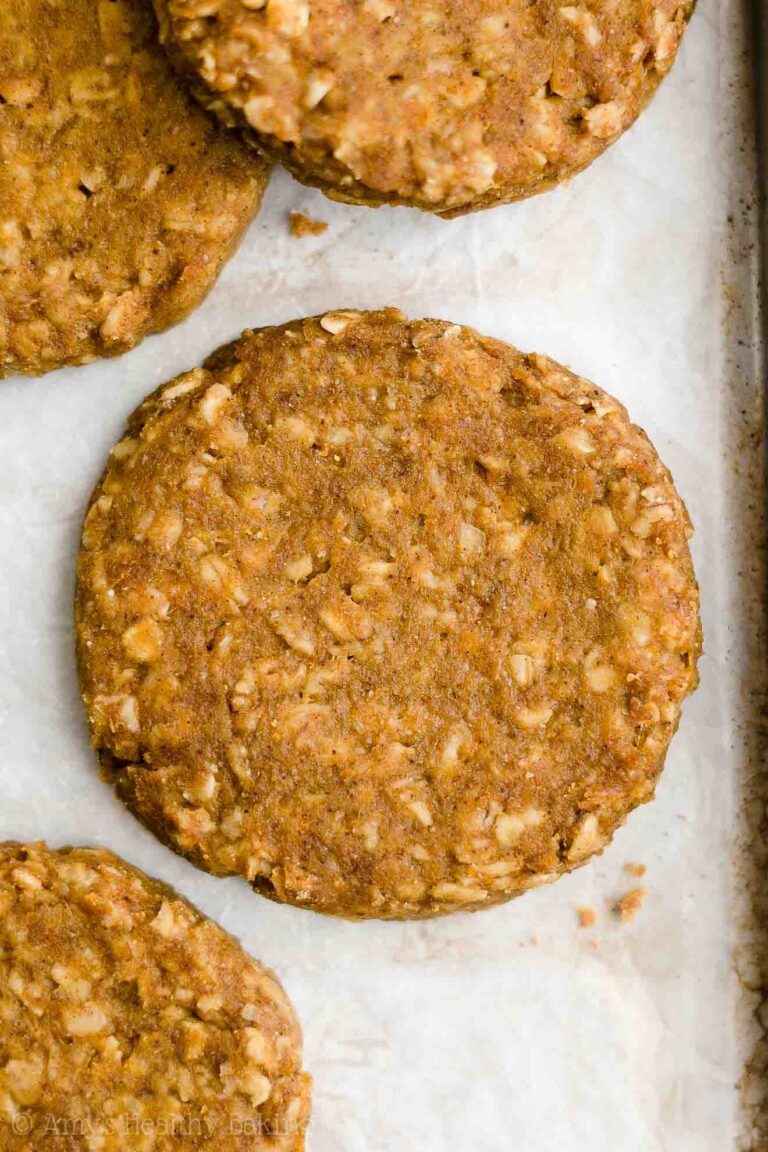Healthy Baking – Healthy Gingerbread Oatmeal Scones
These healthy gingerbread oatmeal scones are perfect for the holiday season! Beautifully tender and moist, these bakery-style scones are lightly sweetened with plenty of soft oats, warm spices, and festive flavor. The dough comes together quickly, and cozy aromas fill your kitchen as it bakes. Paired with a steaming mug of coffee, tea, or even hot cocoa, these scones are a delicious breakfast or snack for any winter day — even Christmas morning!
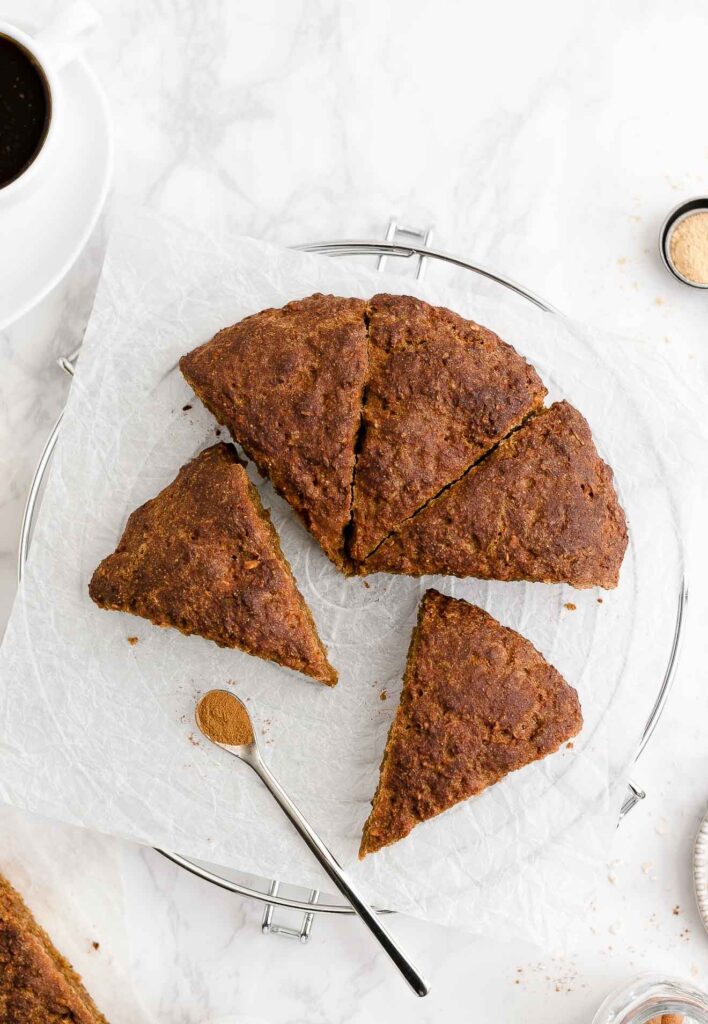

My childhood Christmases followed a fairly similar routine. Each year, as soon as we awoke, my brother and I sprinted into the family room to peek into our stockings and unwrap gifts. My parents and grandparents joined in, each with a piping hot beverage in hand, and we stayed circled around the tree on the sofa and soft carpet until all of the wrapping paper and bows lay discarded in a giant bag to recycle later.
Only then did we begin to think about a “real” breakfast… Not just bits of toast and chocolate candies fished out from the toes of Santa’s stockings!
It often involved fluffy scrambled eggs and crispy strips of bacon, but occasionally, my grandma pulled out flour, sugar, and mixing bowls to bake her special breakfast pastry. She carefully made the dough, rolled it out into a thin rectangle, and sliced sections into thin strips. After spooning jam down the center, she painstakingly twisted those strips across the top and tucked them into the edges to form a plait. Once satisfied, she slipped the pan into the oven, and we waited for the timer to ring.
Rather impatiently, I’m afraid… Little kids with rumbly tummies can only be distracted by brand new Christmas gifts for so long, especially with the smell of buttery dough in the air!

As soon as the jam cooled enough to avoid burning our tongues, Grandma and Mom cut slices of the pastry and slid them onto plates. The flaky layers melted in our mouths, and we almost always requested seconds… And the adults did too!
Between mugs of coffee, cups of tea, and a small nibble whenever we walked through the kitchen, that pastry rarely lasted past midafternoon, and it was always worth the wait — even if our loudly growling stomachs didn’t seem to think so while we watched the oven like vultures or hawks.
Remembering how long that holiday breakfast treat took to prepare, I thought these healthy gingerbread oatmeal scones would be a delicious alternative this year! They’re just as satisfying and festive, and they’re still perfect for pairing with coffee, tea, or even hot chocolate.
In comparison, these scones are also much faster and easier to make… Which is always a huge plus during the busy holiday season!
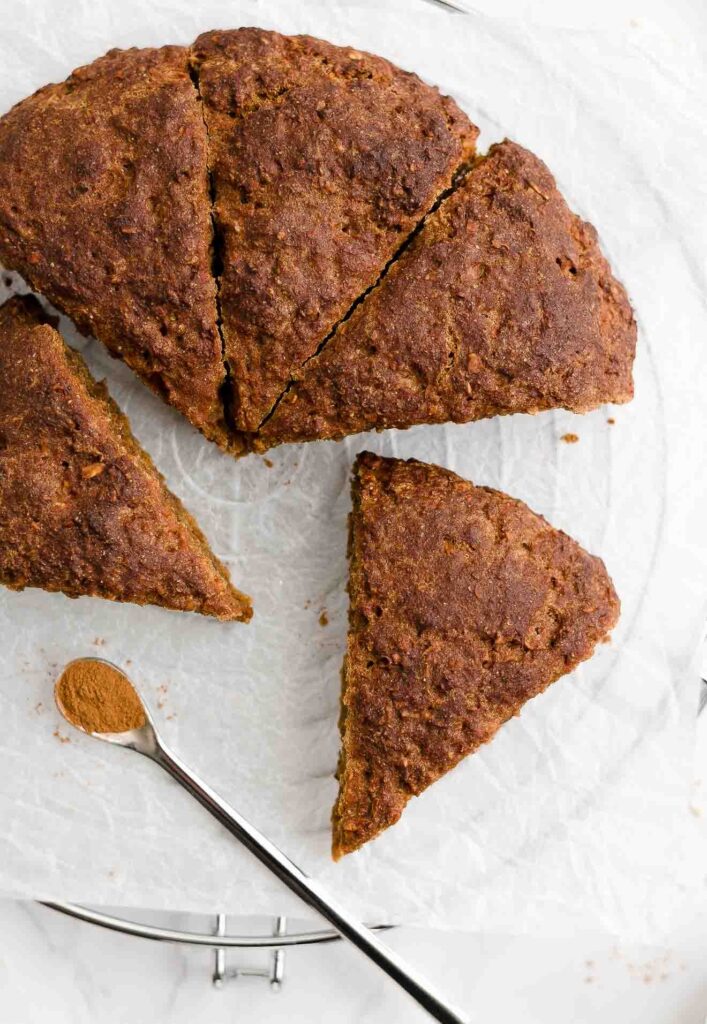
QUICK OVERVIEW – HEALTHY GINGERBREAD OATMEAL SCONES
Difficulty: Mainly easy, including for many beginner bakers.
Taste: Very lightly sweetened, with plenty of warm spices that shine against a comforting backdrop of oats and molasses.
Texture: Moist and tender inside, with a hint of a crust on the outside, and soft oats filling every bite.
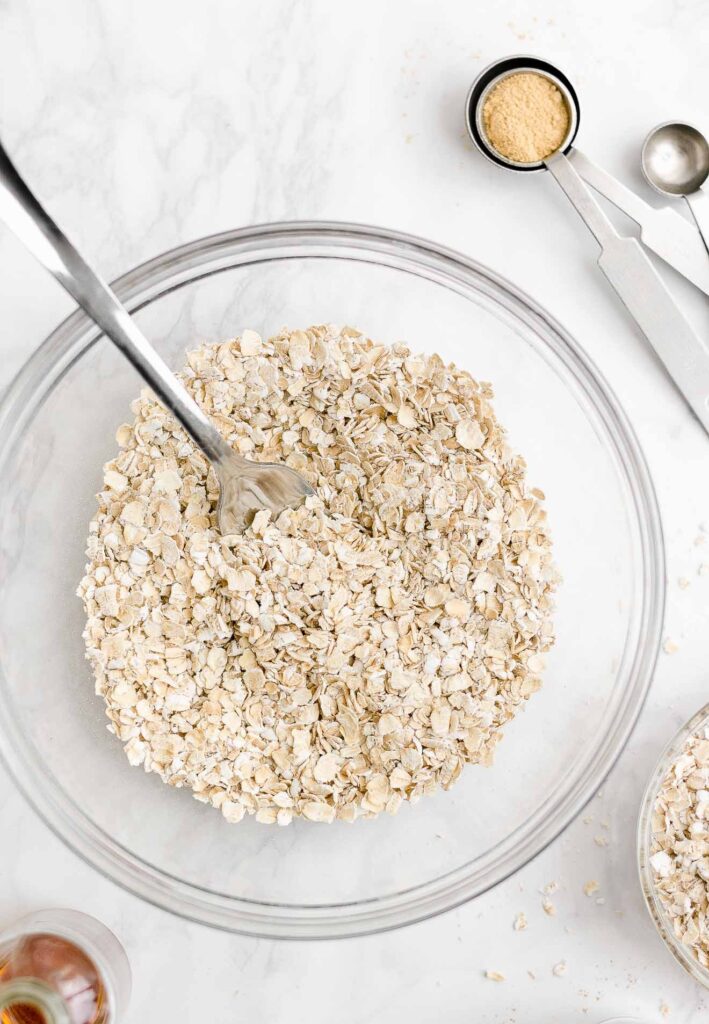
KEY INGREDIENTS TO MAKE HEALTHY GINGERBREAD OATMEAL SCONES
Let’s go over what you’ll need to make these healthy gingerbread oatmeal scones! Many of these items are common baking staples, so there’s a very good chance you have almost everything you need in your pantry and fridge.
Oats. Highly predictable, I’m sure — given the recipe title of “gingerbread oatmeal scones!” You’ll need instant oats to make these scones. They’re also called quick cooking and one-minute oats. Contrary to what many people believe, instant oats are not the ones sold in little single-serving packets with flavors like maple brown sugar and apple cinnamon!
Just like traditional old-fashioned rolled oats, instant oats only contain one ingredient (oats!). However, they differ in one key way… They’re smaller and thinner than their old-fashioned rolled cousins. This size difference plays an important role in these scones! Because they’re smaller, instant oats soften faster, and that yields a beautifully moist and tender texture in your healthy gingerbread scones.
Tip: If you’d like to make your batch of these healthy gingerbread scones gluten-free, substitute certified gluten-free instant oats. They work perfectly!
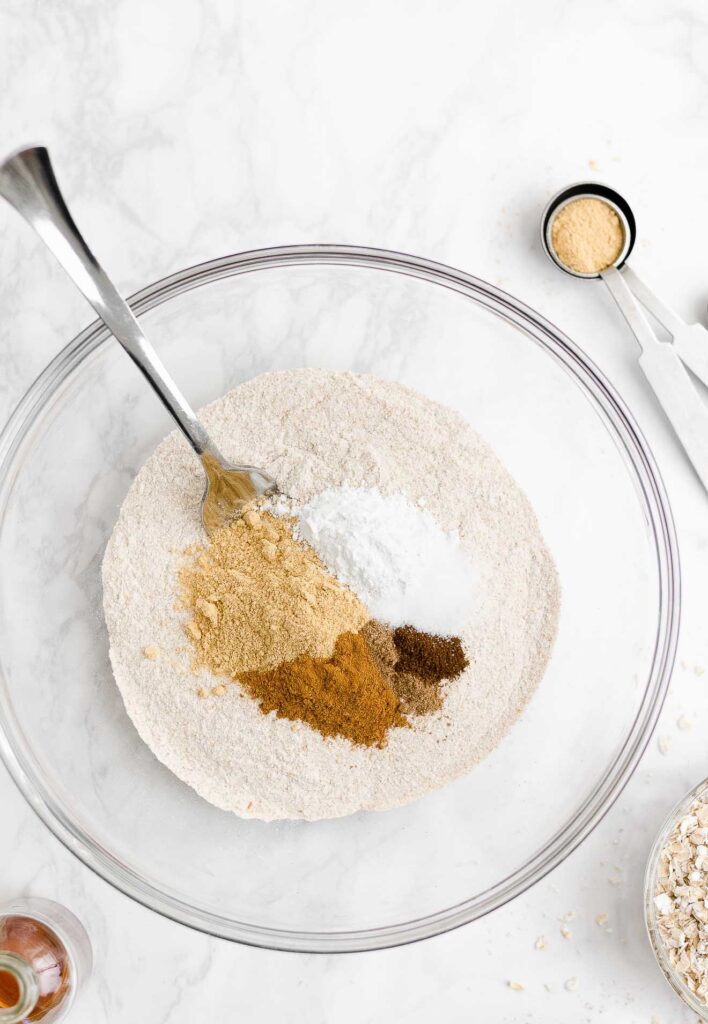
Flour. I opted for regular whole wheat flour to make these scones. I love how it has more fiber and micronutrients! You’ll add plenty of spices (more on those momentarily!), and those mask any sort of “wheat-y” flavor that sometimes accompanies 100% whole wheat baked goods… Meaning your gingerbread oatmeal scones simply taste extra cozy and comforting!
Tip: If you’d like to make your healthy gingerbread oatmeal scones gluten-free, I’ve shared my top flour recommendations in the Notes section of the recipe.
Spices. They create half of that iconic warm and cozy gingerbread flavor! You’ll need ginger (obvious, I’m sure!), along with cinnamon, nutmeg, and cloves. Ginger provides that bright and spicy zip of flavor, while the other three create a richer, deeper, and fuller flavor profile.
Tip: Saigon cinnamon is my favorite. It’s slightly sweeter, stronger, and richer than regular cinnamon, so it yields an even better flavor. It’s basically the only kind I now use in my baking! Although it’s starting to appear in many mainstream grocery stores, I often buy it online here. (It’s really affordable too!)

Unsalted butter. Just like in classic scone recipes, you’ll use butter to make these. However, the amount is different! Traditional recipes often call for a full stick or two (anywhere from ½ to 1 full cup!), but you only need 1 ½ tablespoons to make these. That helps keep your healthy gingerbread oatmeal scones low calorie and low fat in comparison!
Yet they’re still really moist and soft, and that’s thanks to one of my favorite ingredients in healthier baking…
Greek yogurt. That’s right — no heavy cream in these scones! Greek yogurt adds the same moisture as cream (or extra butter!) but for a fraction of the calories. It also gives your gingerbread scones a protein boost!
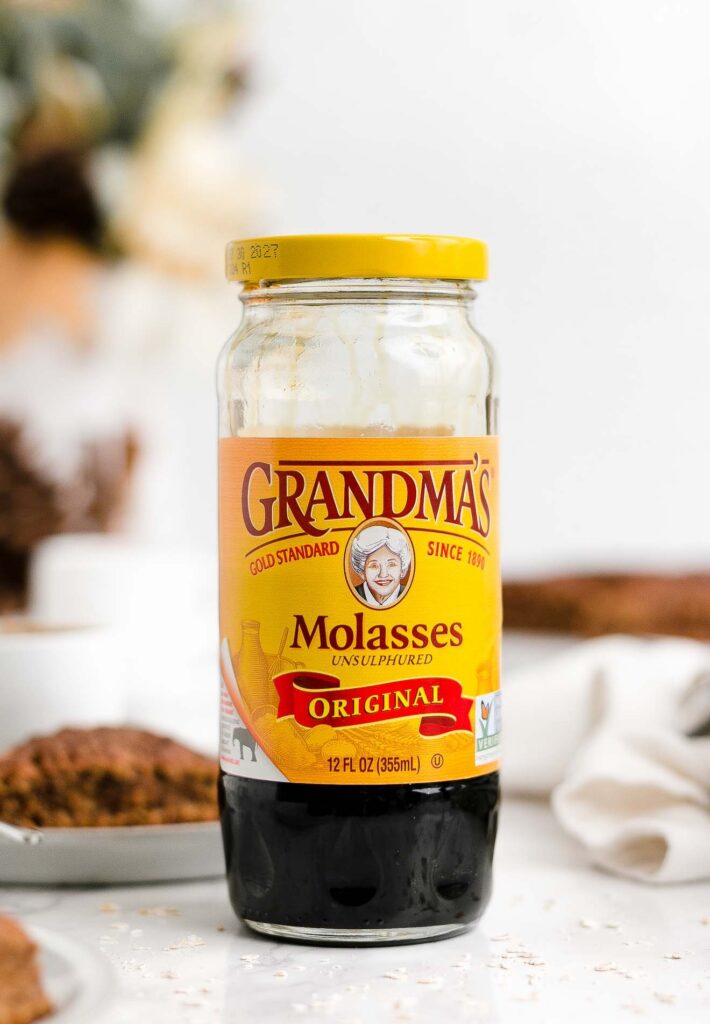
Molasses. This creates the other half of that classic cozy gingerbread flavor! Molasses is a dark brown liquid sweetener with a consistency similar to honey. It has a deep, rich, almost earthy flavor, and it’s a key ingredient in all gingerbread-flavored recipes. (Yes, including gingerbread cookies!)
To make these healthy gingerbread oatmeal scones, you need regular unsulphured molasses — not blackstrap. (The latter is substantially more bitter, so substituting it will ruin the flavor of your scones!) I grew up baking with Grandma’s Molasses, and it’s still the kind I use the most.
Tip: Here in the US, you can often find molasses right next to the pure maple syrup!
Milk. You’ll add a splash to the dough to bring everything together, and you’ll also need a touch more just before you slide the baking sheet in the oven. But wait! I’m getting ahead of myself…

HOW TO MAKE THE BEST GINGERBREAD OATMEAL SCONES
Time to cover how to make these healthy gingerbread oatmeal scones! I have some tips and tricks to share with you, but like I promised earlier, this recipe is simple and straightforward to make.
Measure correctly. Oh my… If I had a penny for every time I mentioned this, I would’ve been a millionaire five years ago. (If only — although that might be wishful thinking on my part!)
It’s really important to measure all of the ingredients correctly, using this method or a kitchen scale. (← That’s the one I own!) This is particularly true of the flour and oats! Too much of either one will dry out the dough, and it can also make your scones bread-like or crumbly… Especially the oats! They act like little sponges and soak up lots of moisture.
For the molasses and milk, use regular measuring spoons — not a kitchen scale! They’re more accurate for liquid ingredients. (There’s a nerdy scientific explanation for why, but in the interest of time and a busy holiday season, I’ll spare you today and keep on going!)
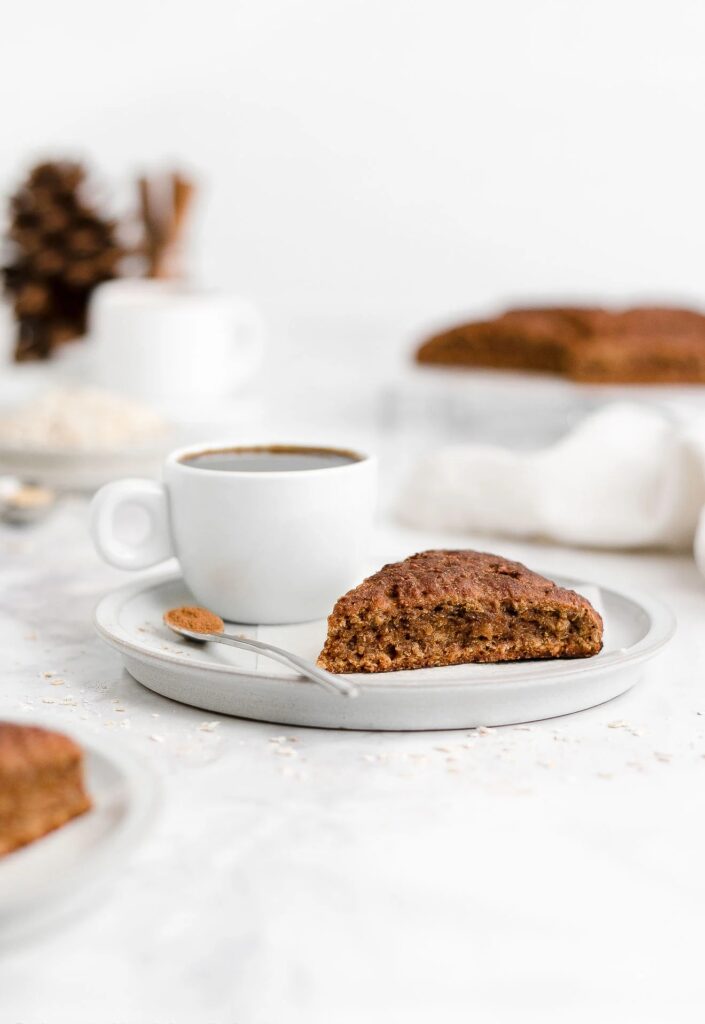
No warm ingredients. For once, you don’t need to plan far enough in advance to pull everything out of the fridge ahead of time! It’s fine for your pantry ingredients to be room temperature, but anything that comes out of the refrigerator (aka the butter, Greek yogurt, and milk!) should be cold.
Cold butter plays a key role in the texture of scones. When you slide them into the oven to bake, the bits of cold butter start to melt, which creates tender little pockets in the dough. If your butter begins to soften or melt ahead of time, like while you’re still measuring other ingredients or mixing them together, it can’t create those little pockets in the oven.
Tip: This is why I highly recommend against substituting coconut oil. It melts at a much lower temperature (around 76°F, compared to butter’s melting point of 95°F!), so it’s often a liquid at room temperature. Even if it’s solid when you begin, it won’t necessarily stay that way while making the dough!
For a dairy-free alternative, use stick-style vegan butter instead. (I really like this one and this one!)
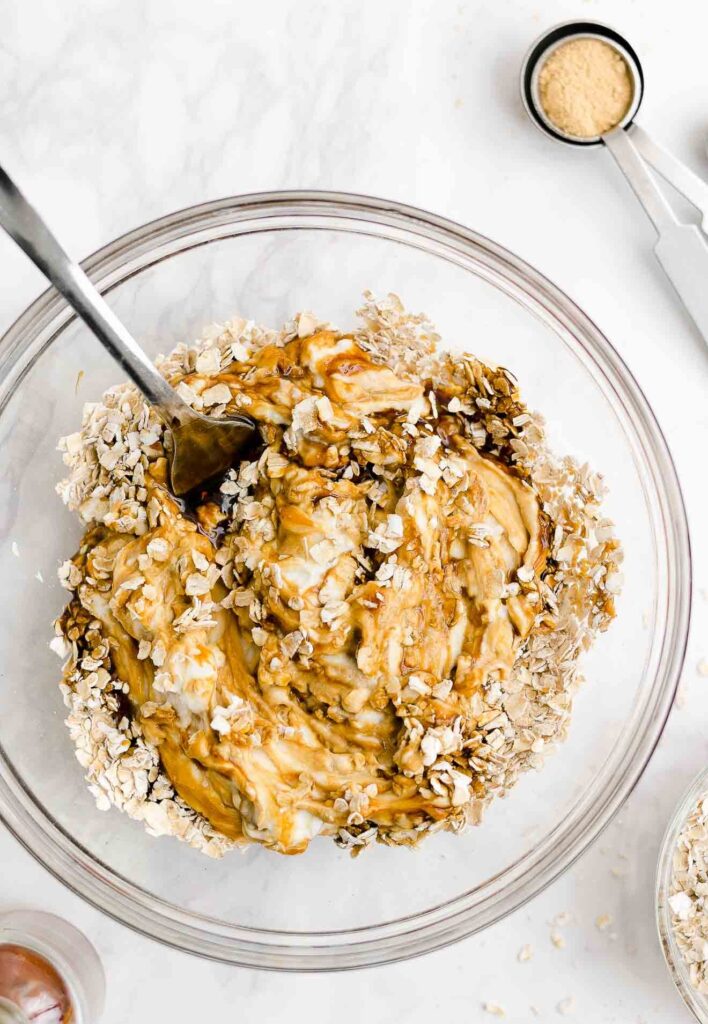
Soak the oats. I’ve already built this into Step 2 of the recipe! By mixing the oats with the Greek yogurt and molasses, you give them a head start on soaking up moisture. Similar to the way my overnight oats recipes work, this helps the oats soften prior to adding them to the dough, which gives your gingerbread scones an even more tender texture.
Use a pastry cutter. They’re so handy to have around! I use mine for making scones, pie crusts, and even mashing bananas for banana bread. I love how a pastry cutter makes the process of working in the butter much faster and easier. Because it takes less time, it lowers the chance of your butter softening too!
Tip: If you don’t have a pastry cutter, you can use the back of a fork instead. (Or maybe put one on your holiday wish list??)
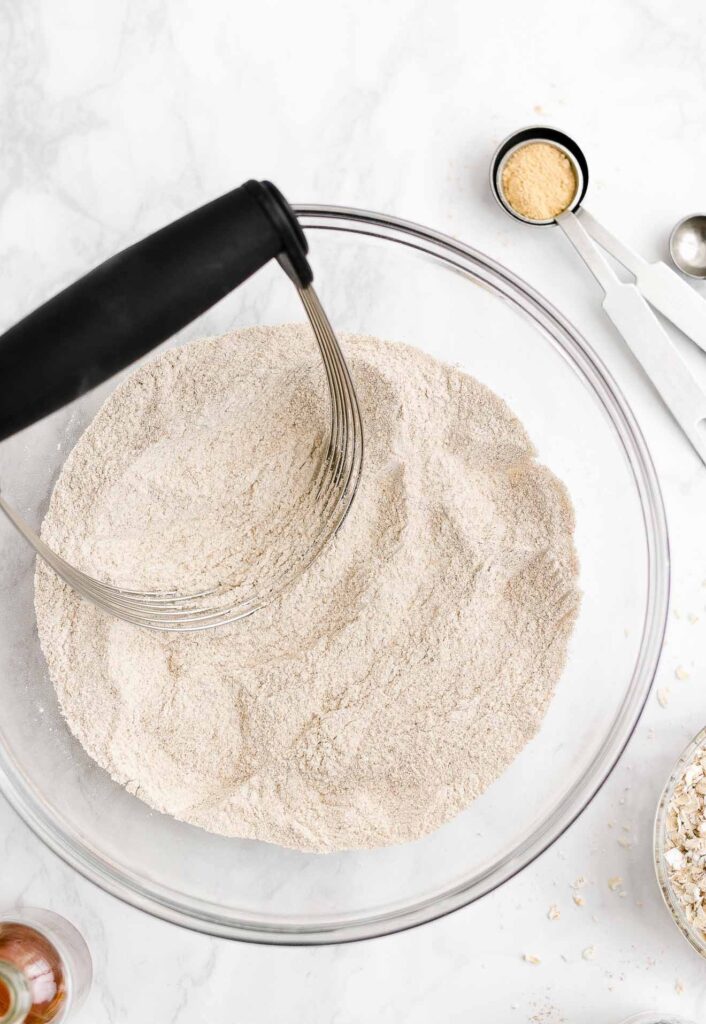
Shape, brush + slice. Once you’ve made the dough and transferred it to your baking sheet, shape it into a circle. It’ll be too sticky for your hands, so use a spatula instead! (I love using mini ones like these. I own more of them than standard-sized spatulas!)
Next, you’ll brush the dough with milk. (I told you I was getting too far ahead of myself!) The milk helps seal moisture into the dough, which yields a beautifully soft texture inside, and it also creates a bit of a crust on the outside.
Finally, slice the circle of dough into 8 wedges, almost like a pizza. Don’t separate them though — leave them touching! By staying nestled up against their neighbors, the sides and insides of your gingerbread oatmeal scones stay perfectly tender and moist.

Bake. It’s time! Slide your baking sheet into the oven, and wait… Patiently or impatiently — it’s up to you. I won’t judge either way! Enjoy the cozy aroma wafting through your kitchen, brew a cup of coffee or tea, and count down the minutes (or seconds!) until the timer rings.
Hint: Because of the molasses’ deep color, your scones will brown quickly and look noticeably dark. Don’t be alarmed! As long as they’re not black, you haven’t burned them. To check for doneness, I often nudge the center where the 8 triangle points meet. It should feel mainly firm with just a little give.
FAQS ABOUT HEALTHY GINGERBREAD OATMEAL SCONES
Are these healthy gingerbread oatmeal scones gluten-free, low calorie, low fat, or clean eating?
Yes — to all of the above! These scones are naturally clean eating, as well as egg-free and nut-free. They’re also low fat and low calorie, compared to more traditional scone recipes. If you’d like to make them gluten-free, I’ve included how to do that in the Notes section of the recipe.
Can I use old-fashioned rolled oats instead?
Kind of! Measure the same amount of old-fashioned rolled oats, and pulse them a few times in a food processor or blender until they’re ⅛ to ¼ of their original size. This makes them closer to the size and thickness of instant oats, so your gingerbread scones will still be soft and moist.
What about a different flour?
Yup! White whole wheat flour, whole wheat pastry flour, and all-purpose flour all work too.

Can I substitute coconut oil for the butter?
Please don’t! It’ll change the texture of your scones. (See the “No warm ingredients” header in the “How to Make the Best Gingerbread Oatmeal Scones” section above for more info!)
What about a different sweetener, instead of the molasses?
I highly recommend not, if at all possible! Molasses is a key component of gingerbread and provides that iconic deep, rich, comforting flavor. It’s not a one-time use ingredient either! You can use it to make all of these other recipes of mine too.
However… I know molasses isn’t always easy to find outside of the US. Pure maple syrup, honey, and agave will yield the same texture — but just keep in mind that the flavor of your scones will be noticeably different if you substitute any of these!
Can I use a different milk?
You sure can! Just about any kind will work, so you’re welcome to substitute whatever you normally keep in your fridge.
What makes these scones so moist?
A handful of things! First, using instant oats (because of their size!) and Greek yogurt. Second, soaking the oats in the yogurt to let them start softening ahead of time. Third, brushing the dough with milk prior to baking. Finally, leaving the wedges of dough touching their neighbors instead of separating them.
For more information about #1, see the “Oats” and “Greek yogurt” headers in the “Key Ingredients to Make Healthy Gingerbread Oatmeal Scones” section above. For the others, see the “How to Make the Best Gingerbread Oatmeal Scones” section for a more in-depth explanation about each one!
Mine turned out dry. Why is that?
There are a few main culprits! The first is incorrectly measuring ingredients, so you’ve ended up with too much flour or too many oats — or not enough molasses or milk. (See the “Measure correctly” header in the the “How to Make the Best Gingerbread Oatmeal Scones” section for more info!) Next, make sure you thoroughly brush the tops and sides of the dough with milk and leave all of the scones touching while baking. Finally, don’t overbake them! The tops and sides should be dark brown (but not black!).
What’s the best way to store these healthy gingerbread oatmeal scones? And how long do they keep?
Store your scones in an airtight container in the refrigerator. They should keep for at least four days (if not closer to a week or more!). I like to briefly reheat individual leftover scones before eating. Just pop them in the microwave for a few seconds! This makes their insides beautifully soft and moist again — almost as if they’ve been freshly baked!


Healthy Gingerbread Oatmeal Scones
These healthy gingerbread oatmeal scones are perfect for the holiday season! Beautifully tender and moist, they’re lightly sweetened with plenty of soft oats, warm spices, and festive flavor. Paired with a steaming mug of coffee, tea, or even hot cocoa, these scones are a delicious breakfast or snack for any winter day — even Christmas morning! Leftover scones will keep for at least four days (if not longer!) if stored in an airtight container in the refrigerator.
-
Preheat the oven to 425°F, and line a baking sheet with a silicone baking mat or parchment paper.
-
In a medium bowl, stir together the oats, Greek yogurt, molasses, and vanilla extract. In a separate bowl, whisk together the flour, baking powder, ginger, cinnamon, nutmeg, cloves, and salt. Cut in the butter with a pastry cutter (highly recommended!) or the back of a fork until the mixture resembles fine crumbs. Make a well in the center. Pour in the oat mixture and ¼ cup of milk. Stir them together, then gradually stir in the surrounding flour mixture until just incorporated.
- Transfer the dough to the prepared baking sheet. Using a spatula, shape the dough into a ¾” tall circle, and brush with the remaining milk. Slice the dough into 8 triangular segments with a sharp knife (but don’t separate them!). Bake at 425°F for 28-31 minutes, or until the tops are deep brown and the center feels firm to the touch. Cool on the pan for 5 minutes before transferring to a wire rack to cool completely.
IMPORTANT BAKING NOTES – READ BEFORE BEGINNING: Do not separate the 8 dough wedges before baking in Step 3. Instead, leave them touching on the baking sheet! This helps make the insides really moist, soft, and fluffy.
Because of the molasses, these scones brown more quickly and turn substantially darker than other scones. Don’t be alarmed — if they’re not black, then you haven’t burned them!
IMPORTANT FLAVOR NOTE – READ BEFORE BEGINNING: As written, these scones aren’t overly sweet. If you prefer sweeter scones, substitute pure maple syrup, honey, or agave for an equal amount of milk in the dough. (For example, use 2 tablespoons of pure maple syrup, and decrease the milk in the dough to 2 tablespoons.)
If you like a stronger spice flavor in your gingerbread (like I do!), then use an extra ¼ to ½ teaspoon (or up to 1 teaspoon!) of ground ginger.
OATS NOTES + ALTERNATIVE: Instant oats are also known as “quick-cooking” or “one-minute” oats. They’re smaller and thinner than old-fashioned rolled oats. (They’re not the ones that come in individual brown paper packets with flavors like “apple cinnamon” or “maple brown sugar.”) Instant oats only have one ingredient: oats!
In a pinch, to make your own, add the same amount of old-fashioned rolled oats to a food processor, and pulse 10-12 times, or until the oats are about ¼ to ⅛ of their original size.
FLOUR ALTERNATIVES: White whole wheat flour, whole wheat pastry flour, or all-purpose flour may be substituted for the regular whole wheat flour.
SPICE NOTES: I highly recommend Saigon cinnamon! It’s a bit stronger, richer, and sweeter than regular cinnamon. Many grocery stores now stock it, but I normally buy it online here. (It’s basically the only kind I use in my baking recipes now!)
I prefer my gingerbread on the spicy side, so I often add an extra ½ teaspoon of ground ginger.
IMPORTANT BUTTER NOTES + ALTERNATIVE: It’s very important that your butter is cold, straight from the fridge. (Freezing it isn’t necessary for this recipe!) With very cold butter, it won’t soften or melt until you put the scones in the extremely hot oven, and it will create little air pockets and a very tender crumb when it melts.
For this reason, I don’t recommend substituting tub-style spreadable butter. (It’s already soft and more likely to melt!) I also don’t recommend substituting coconut oil. It melts at a much lower temperature, which affects the texture of your scones. (See the “no warm ingredients” header in my blog post above for more information!) If you do decide to substitute spreadable butter or coconut oil, just keep this in mind!
Salted butter may be substituted for the unsalted butter. For a dairy-free option, I recommend using stick-style vegan butter instead. (I really like this one and this one.)
SWEETENER ALTERNATIVES: I don’t recommend substituting anything for the molasses, if at all possible. It’s required to produce the iconic gingerbread flavor. Do not use blackstrap molasses; it’s too bitter.
However, I understand it can be hard to find molasses outside of the US, so in a pinch, you can substitute pure maple syrup, honey, or agave. They’ll produce the same texture, but keep in mind your scones will have a noticeably different flavor.
I don’t recommend substituting sugar-free maple syrup. Because it’s often water-based, it makes the scones turn out denser and collapse some while cooling.
MILK ALTERNATIVES: Any milk may be substituted for the nonfat milk.
EGG-FREE VERSION: No modifications necessary!
DAIRY-FREE + VEGAN VERSION: Use stick-style vegan butter (I like this one and this one). Substitute your favorite dairy-free yogurt in place of the Greek yogurt and your favorite dairy-free milk in place of the nonfat milk.
GLUTEN-FREE OPTION: Use certified gluten-free instant oats (or use certified gluten-free old-fashioned rolled oats to make a DIY version, as outlined above!). For the gluten-free flour, use the following blend: ½ cup (60g) millet flour, ¼ cup (30g) tapioca flour, ¼ cup (30g) brown rice flour, and ½ teaspoon xanthan gum. Many store-bought gluten free flour blends (I like this one from Bob’s Red Mill) will work as well, if they’re measured like this.
HOW TO STORE: Store your scones in an airtight container in the refrigerator. They’ll keep for at least four or five days, if not longer.
I highly recommend reheating leftover scones in the microwave before eating. It really improves their texture and makes them soft and fluffy again! I heat them on 30% power until they’re warmed all the way through.
These scones also freeze really well!
{gluten-free, egg-free, dairy-free option, vegan option, clean eating, low fat}
View Nutrition Information + Weight Watchers Points
You may also like other recipes…
♡ The Ultimate Healthy Gingerbread Cookies
♡ Healthy Gingerbread Oatmeal Breakfast Cookies
♡ Healthy Gingerbread Oatmeal Snack Cake
♡ Healthy Gingerbread Muffins
♡ Healthy Pumpkin Oatmeal Scones
♡ Healthy Carrot Oatmeal Scones
♡ …and the rest of Amy’s healthy scone recipes and healthy gingerbread-flavored recipes!



